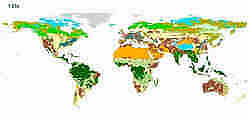This complex theme deals primarily with interactions between organisms and the environmental factors that impact them, but to a greater extent between individual inanimate environmental factors.
innovations-report offers informative reports and articles on topics such as climate protection, landscape conservation, ecological systems, wildlife and nature parks and ecosystem efficiency and balance.

New Report on 25 Most Endangered Primates Documents Increased Pressures on Mankind’s Closest Living Relative
New evidence of the peril facing the world’s apes, monkeys, lemurs and other primates, with one in every three now endangered with extinction, is revealed in a new report – The World’s Top 25 Most Endangered Primates-2002 released today by Conservation International (CI) and the Primate Specialist Group of IUCN-The World Conservation Union. Primate species and su

The plant Bizkaiko Txin-Txor Berziklategia (BTB), located in La Orkonera, Ortuella (Bizkaia, Basque Country) is the first plant of the Basque Autonomous Region dedicated to the assessment of waste derived from construction and demolition. Its set up, after an investment of 2,6 million euros, is going to prolong the average life of dumping sites.
The construction company Pavisa and the public corporation Garbiker, dependent on the Regional Council of Bizkaia, have designed the plant BTB for

University of Georgia scientist leads team
A team of researchers, led by a University of Georgia scientist, has developed the first transgenic system for removing arsenic from the soil by using genetically modified plants. The new system could have a major impact on arsenic pollution, which is a dramatic and growing threat to the environment and to human and animal health worldwide.
The scientists were able to insert two genes from the common bacterium Escherichia coli that allow

Harmful algal blooms, or HABs, can harm fish, birds and even people who are exposed to the toxic algae. HABs come in many forms, including a red tide that regularly affects Florida waters, a brown tide organism, and Pfiestera piscicida, an algae associated with fish kills. Scientists are unsure of exactly what causes the blooms, but a Woods Hole Sea Grant research team may have come up with a way to treat the increasingly common occurrences. Don Anderson and Mario Sengco are testing the use of clay t

While many scientists and policy makers have focused only on how heat-trapping gases like carbon dioxide are altering our global climate, a new NASA-funded study points to the importance of also including human-caused land-use changes as a major factor contributing to climate change.
Land surface changes, like urban sprawl, deforestation and reforestation, and agricultural and irrigation practices strongly affect regional surface temperatures, precipitation and larger-scale atmospheric cir

Downstream from mining sites, a suffocating gel forms in the water of creeks and rivers. A new study by an international team of researchers details the processes that make that gel and should advance our understanding of the damaging environmental effects of mine drainage and acid rain.
“This new nanoscale level of understanding of trace metal pollution of streams opens new doors for addressing the problem of contaminated waters in affected areas,” says Sonia Esperanca, program director in